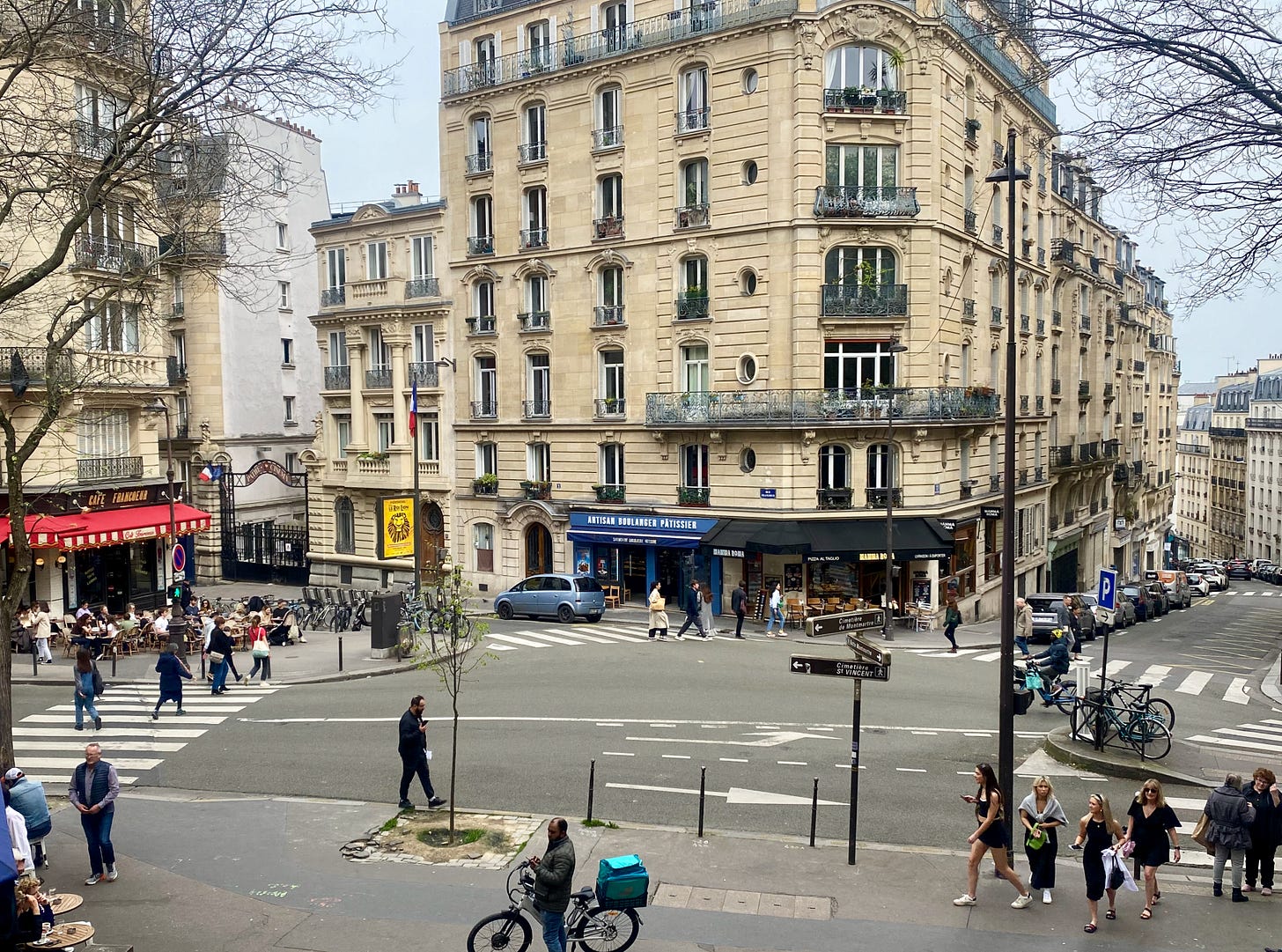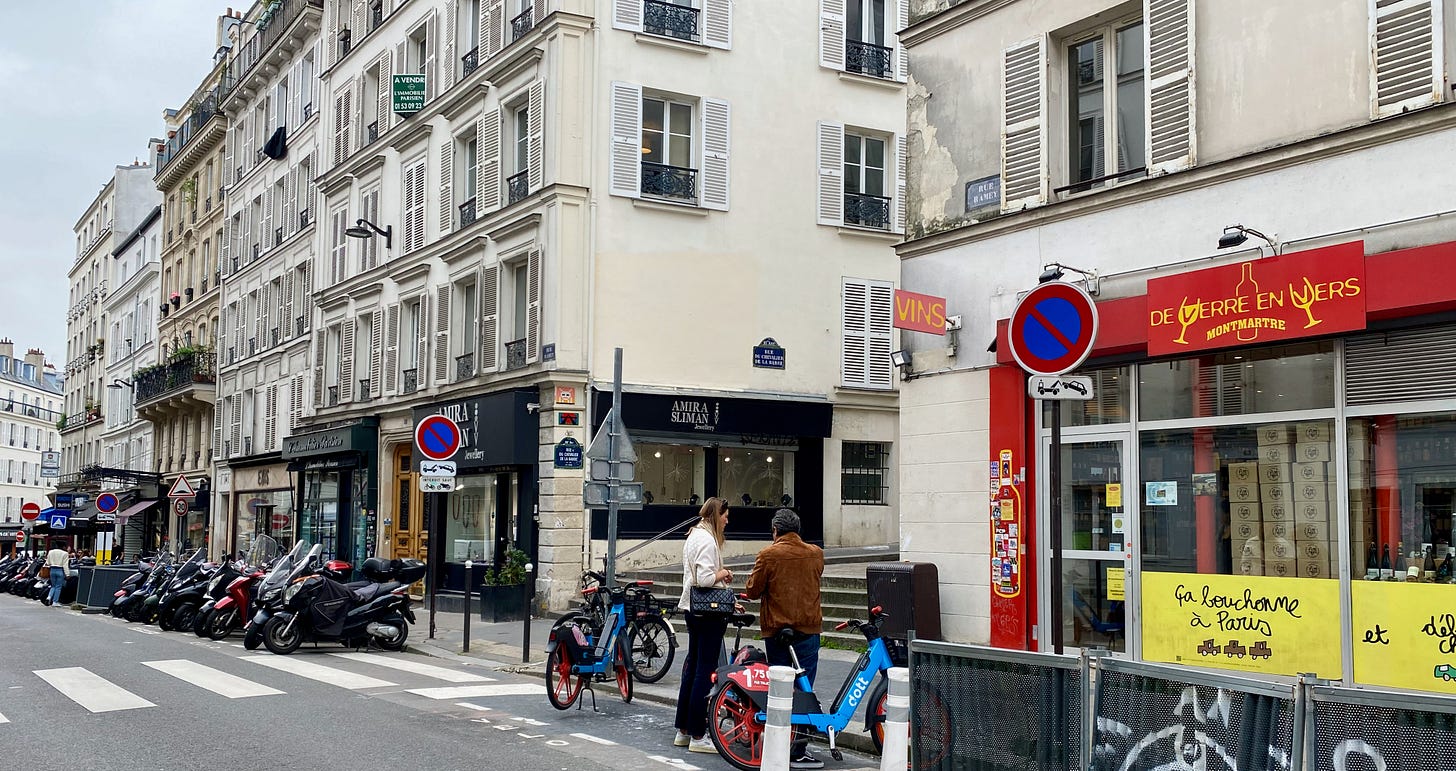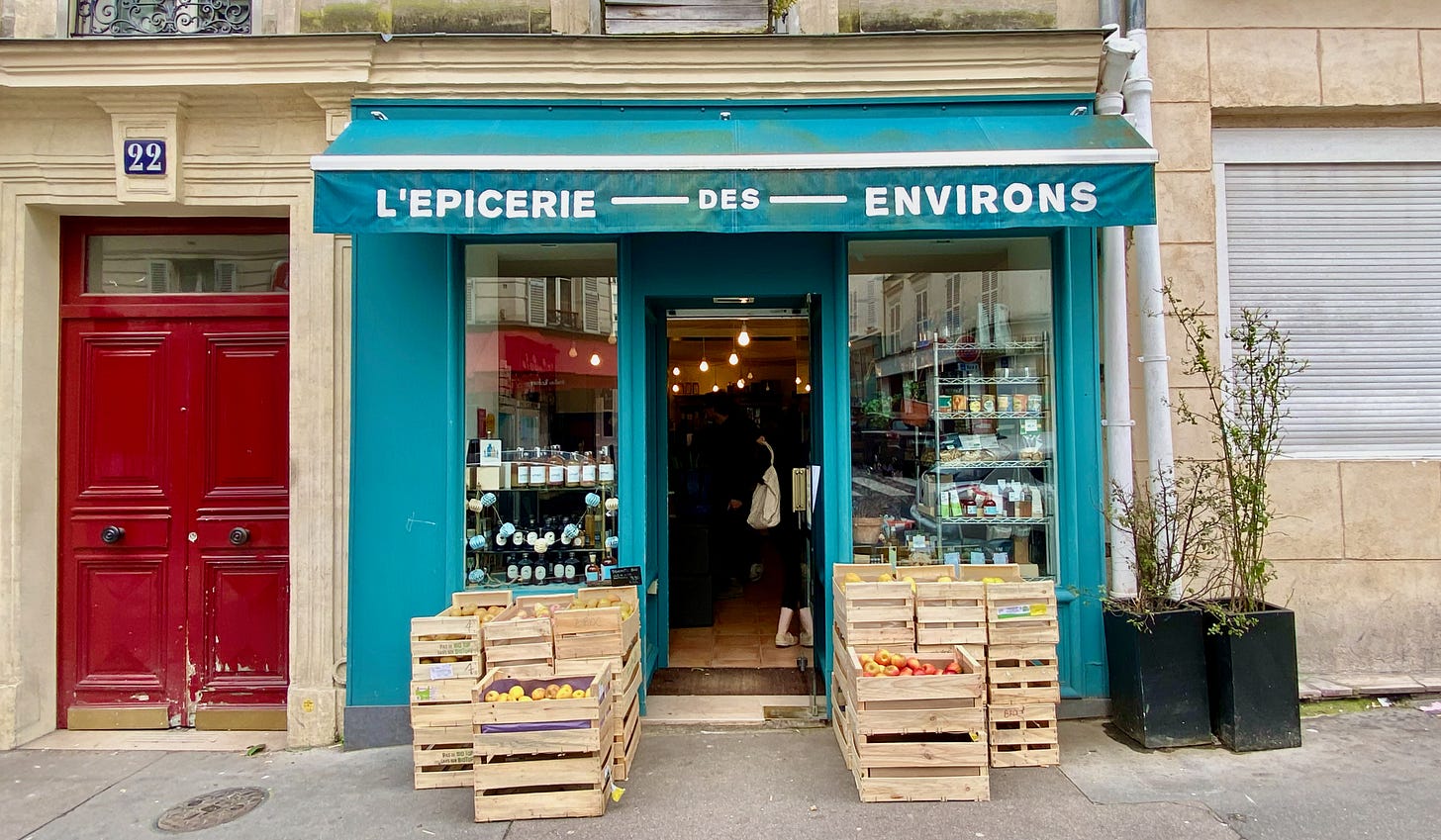The French flag, called the tricolore, is beautiful in its bold simplicity and its evocation of France's bedrock cultural values of liberté, égalité, and fraternité. France isn't as flag-crazed as the United States is, so spotting a tricolore still stirs joy in me, a welcome reminder of the wonderful adventure I'm on and my great fortune to wake up every day in this place.
You'll spot a modest but proud tricolore as you take the grand double staircase down the ancient rue du Mont-Cenis, which traverses the back of the Montmartre butte. I used to live five minutes from those steps, up the graceful slope of rue Caulaincourt, and the tricolore marked the outer limit of what I considered my neighborhood. My every daily need, including and above all an excellent bakery, could be met on the short stretch of rue Caulaincourt between my home and that happy flag.

At that time the logistics of arranging a professional apartment move were beyond my meager French skills. So, one sunny Saturday last autumn I walked box after box after box to the flag, crossed the invisible threshold it marks, and walked five more minutes to my newly acquired digs on the rue Custine.
In Paris's tightly wound geography, being five minutes in the other direction of the flag means being in a completely different neighborhood—one much more lively and mixed than stuffy old Square Caulaincourt, which suits this ex-New Yorker's sensibilities just fine. Unfortunately, the new apartment is now ten minutes from my old bread haunt; too distant for a daily baguette, I relaunched the delicious search for a replacement boulangerie.
I started with the rue Ramey, a street that runs up and over the low shoulder of the big hill. The street has been there since the 1300s, when it was a dirt path connecting a few outlying villages and farms to the small riverside city of Paris. The capital long since subsumed the street and those villages, and a short first walk up rue Ramey revealed a rather ordinary Paris thoroughfare: slightly (though not off-puttingly) shabby, thick with traffic fumes, and lined with unremarkable shops, none offering fresh bread fait maison. So I continued the boulangerie hunt elsewhere.
In the meantime I learned to rise early enough to grab a loaf from the limited supply baked and delivered fresh every morning to Bizas, the small locally-owned grocery across the street. Bizas doesn't stock everything, but what they do carry is thoughtfully selected and of high quality. Buying in limited volumes from small producers isn't a bargain-basement business model, and prices at Bizas are consistently but justifiably higher than for mass-market products at a chain supermarket. Still, when I moved to Paris I vowed that, whenever I could, I would patronize the city's abundant small independent businesses, and I appreciated the chance to put that commitment into action. Bizas became my grocery store.
One day, hunting for spices that Bizas doesn't carry, the unfailingly polite staff referred me to l'Épicerie des Environs, a competitor around the corner on rue Ramey. There I found what I needed, and she—the charmingly tiny shop seems to be run entirely by one friendly and industrious woman—sells many things in bulk, helping to reduce the endless and unnecessary waste of our daily shopping. So I added her shop to my grocery run, to grab anything Bizas didn't carry.
If these two épiceries are competitors, they seem to be friendly ones. Each serves an essential and complementary role in a hyperlocal food ecosystem that includes a fromagerie, whose shop next to l'Épicerie des Environs fills the sidewalk with the rich fragrance of his irresistable artisanal cheeses. I only rarely cook with meat, but when I need a few sausages I can call on the knowledgeable butcher on rue Ramey. When I need a break from all that shopping I can grab a chai at the Indian Social Club, a brightly colored coffee and tea house that reminds me of the ramshackle and friendly local roasteries of my youth.
So it is that, in the six months since the boxes and I took up residence on rue Custine, a single block of the unremarkable and exhaust-filled rue Ramey has become like my personal kitchen pantry.
I've come to know a few other places along the street, too, including the wonderful staff at an intimate bar near the peak of the shoulder. They now greet my partner and me by name and with the same bises they offer to longtime regulars. I'm a dedicated barfly but was never made to feel so welcome in New York as I am at this local watering hole.
They other day, along the three-minute walk to the bar, I counted an astonishing thirty-eight businesses. Among them are three modest little hotels, two excellent coffee shops, nine restaurants of varying cuisines and price points, and assorted practical offerings like a bottle shop and florist. I was astonished to realize so much commerce is packed into this short stretch of umremarkable street.
After my drink with the bar crew I took my time returning home, looking closely to discover everything I'd missed or dismissed on my earliest walks on rue Ramey. Here was a shoe shop displaying the price of each item on a tiny seashell. Next to it a jeweler colorful, elegant, individually designed pieces. They're right by the wonderfully idiosyncratic bottle shop which has introduced me to several interesting French spirits. Tucked into a dilapidated old building is a takeout stand offering the unlikely combination of crêpes and sushi. I counted four real estate offices—far too many and indicative of the neighborhood's rising prices—and noticed the tiny street front headquarters of an electronic music label.
This three-block, three-minute stretch of street is more than just my kitchen pantry. It also serves the needs of an entire microneighborhood. Paris is replete with small food shops, and there are butchers and cheesemongers a few minutes' walk in the other direction of my apartment. So the shops on rue Ramey must be sustained by a small but loyal audience of very local residents like me, we who live well within the tight five-minute radius that comprises a Paris neighborhood.
Shops like these are too small to serve every need, so they specialize. They get to know their customers as neighbors, observing their needs and preferences firsthand. Then they offer just the right products to meet those hyper-local, hyper-specific needs. Larger merchants, like the local outlet of the Carrefour supermarket chain, can't offer that; they manage stocks using computer systems, and their staff and customers are abstractions. Our Carrefour is more or less interchangeable with the one a few blocks away, and its competitor Franprix, and every other chain supermarket across the capital.

The marketing world has a word for the careful selectivity of the small merchants: curation. It's a word that is used too often and sometimes rings hollow, as when a skincare company backed by mountains of venture capital claims to have perfectly curated a line of products for you without having ever laid an eyeball on you. Curation, today, is meaningless; just another phrase to sell what big corporations tell us we need.
My cheesemonger, though, can learn what I actually need and like. He can serve made-to-order sandwiches using bread from a bakery up the street rather than by a massive suburban factory. The woman at the épicerie can deduce from my request for small quantities of specific spices that I'm making vin chaud, and can make a mental note to keep those spices in stock as the weather turns colder. The bar can offer me a taste of a spirit they're trying out and, if I like it, work it into the cocktail menu.
That's not just curation. It's commerce based on relationships. It's commerce based on a very specific place. It's urban terroir.
Slowly, one wedge of cheese and one bottle of olive oil at a time, I'm becoming part of the daily rhythm of rue Ramey. I see that glint of recognition in the eyes of the shopkeepers ("Uh-oh," I imagine them thinking, "here comes blondie with his terrible French!"). And what I once saw as a row of unremarkable shops I now see as individual businesses with names, stories, personalities, and points of view. I observe the almost universal commitment of these shops, despite the cost and difficulty, to the idea of small, local, ethical commerce and to their role in the life of this neighborhood. With each visit and each interaction I accrue meaning; this street, still filled with exhaust but far from ordinary, is becoming more fully alive to me.
This is a good moment to acknowledge what makes Paris pretty different from its American counterparts. In America, quality cheesemongers, specialist butchers, and small épiceries are an exceedingly rare and often expensive, increasingly just a luxury to provide an atmosphere of "authenticity" to neighborhoods like the West Village or Silverlake. But in Paris these small businesses are everywhere, an everyday feature of neighborhoods of every income, culture, and taste. French culture in general, and Parisian culture in particular, places a high value on local small businesses and especially those selling food. The days of great Les Halles market supplying shops across the capital with the bounty of the provinces may be long gone, but the ecosystem of small food outlets like these remains strong in Paris neighborhoods (if not necessarily in smaller towns and villages elsewhere in the country, where the destructive influence of enormous chain supermarkets is evident).
But small shops also flourish for reasons beyond cultural values and practices. The Paris city government plays an unusually active role in supporting small businesses, even serving as landlord of commercial spaces, which helps moderate the hyperactive market forces that have decimated neighborhood retail in cities like New York. This approach is part of a package of financial and policy supports, including a strong commitment to making housing affordable for people across the income spectrum, that seeks to keep Paris's vibrant, creative, and socioeconomically mixed.1

Land use also matters. While Paris lacks the skyscrapers we associate with bustling urban centers, it is in fact one of the densest cities in the world. Dense populations can support a rich ecosystem of small businesses and the evolution of microneighborhoods with their own identities. My épicerie isn't trying to attract shoppers from across the city, or even from elsewhere in the 18th arrondissement; her target market is me and my immediate neighbors. Imagine unfolding a map of Paris and covering it in circles, each representing a three-minute walking radius within which all the daily basics exist. With the city covered in hundreds of such circles, and each circle filled with many people and many shops and services, it would be easy to see how the city's neighborhoods feel like vibrant little villages.
The daily experience of living here, and visiting rue Ramey once or a few times a day, makes a compelling argument for the joy of urban life. I love how idiosyncratic everything is: the vibrant color, the friendly personalities, the ease with which I can find goods made by small producers, the particular local focus on ethical trade and environmental responsibility. I have even come to love what previously intimidated me: the need for conversation as part of almost any everyday transaction. I love that I have to ask the butcher which sausage I should buy, because he makes me describe what I'm making (good French practice!) and then tells me exactly how to cook his sausages to make sure they come out right. I love these idiosyncracies and interactions because, just like the tricolore, they remind me that my feet are on the ground in this specific place.

I lived for a number of years in a master-planned Southern California suburb, an environment that couldn't feel more different than my Paris neighborhood. Back then it also took me about three minutes to get to the grocery store, but I drove there, because the walk took 25 minutes alongside six lanes of 55-mph traffic. The store was like any American supermarket; it had the butcher counter, the bakery counter, the produce, the dry goods, all the individual components of local commerce now under one enormous roof.
I don't think I ever had a real conversation with anyone at the supermarket. They certainly didn't ask me how I intended to use these spices or offer advice on cooking a pasta sauce. Everything was standardized, sterile, and anonymous. And it didn't much matter whether I went to that store or the one a few minutes farther down the road; all of the supermarkets were essentially the same, offering the same selection of goods from the same big corporate and industrial producers to customers who mostly looked the same, dressed the same, lived in nearly identical houses, and shared the very same cultural references.
That's what so much of American commercial life has been reduced to: corporate sameness. But getting our daily needs met, out in public, together, with a bit of chat and the occasional surprise, is what makes cities hum with life! Those couple of blocks of rue Ramey bring richness and color into my everyday life. They help connect me to this place, and the ethos of the merchants reinforces my own commitment to shop locally and support this community. This place builds meaning in my life. That connection to place is what travel is all about, and it's been illuminating to discover how rich a journey lies a three-minute walk out my front door.
For a thoughtful and well-researched look at the threat gentrification poses to Paris, see Cole Stangler's Paris Is Not Dead. Stangler's take is more skeptical than mine about the present state and future direction of Paris. And for informative and readable takes on what happens to a city absent such active policy supports, see Roland Atkinson's Alpha City: How London Was Captured by the Super-Rich and Sharon Zukin's Naked City: The Death and Life of Authentic Urban Places.






Thank you for introducing your neighborhood to me. Though I've been to Paris many times over 50 years, I've always stayed in the 5th (MY neighborhood, though I've never actually lived there!), and have only been to the 18th a couple of times, so it's good to get a closer glimpse of your streets there. I have a sense of what you describe (though still only as a visitor) from going to the same bistros, the same bakeries, staying in the same hotel on every visit for decades now. I do know the pleasure of seeing the Chef and Madame from Lilane in a cafe on Place Contrascarpe - and they greet me(!), having the waitperson at our usual cafe on Rue Mouffetard put my forgotten hat behind the bar to wait, because she knows I'll be back - in a day or two at least. I always hoped I'd someday live in Paris; now I know I never will - that's life. But I'm enjoying immensely reading your pieces about your life there.